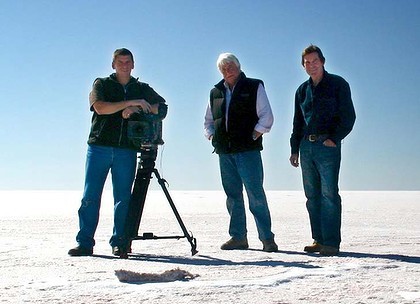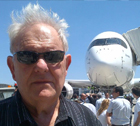The Australian air safety investigator the ATSB has found that the pilot of the ABC helicopter that crashed at Lake Eyre two years ago, killing all three people onboard, had become ‘spatially disoriented’ after taking off in the dark and may have been distracted by reprograming a GPS navigational unit.
Journalist and author Paul Lockyer, cameraman John Bean and their pilot Gary Ticehurst died in the 18 August 2011 crash when their Aerospatiale Industries AS355 chopper went down in part of the Cooper Creek locality, about 145km north of Marree.
The ATSB summarises the events as follows:
An Aérospatiale AS355F2 (Twin Squirrel) helicopter, registered VH-NTV, was being operated under the visual flight rules (VFR) in an area east of Lake Eyre, South Australia. At about 1900 Central Standard Time, the pilot departed an island in the Cooper Creek inlet with two film crew on board for a 30-minute flight to a station for a planned overnight stay. It was after last light and, although there was no low cloud or rain, it was a dark night. The helicopter levelled at 1,500 ft above sea level, and shortly after entered a gentle right turn and then began descending. The turn tightened and the descent rate increased until, 38 seconds after the descent began, the helicopter impacted terrain at high speed with a bank angle of about 90°. The pilot and the two passengers were fatally injured, and the helicopter was destroyed.
The ATSB found that the pilot probably selected an incorrect destination on one or both of the helicopter’s global positioning system (GPS) units prior to departure. The ATSB concluded that, after initiating the right turn at 1,500 ft, the pilot probably became spatially disoriented. Factors contributing to the disorientation included dark night conditions, high pilot workload associated with establishing the helicopter in cruise flight and probably attempting to correct the fly-to point in a GPS unit, the pilot’s limited recent night flying and instrument flying experience, and the helicopter not being equipped with an autopilot.
The Civil Aviation Safety Authority (CASA) has advised of safety actions in progress to clarify the nature of what is meant by the term ‘visibility’ in dark night conditions, provide enhanced guidance on night VFR flight planning, and provide enhanced guidance on other aspects of night VFR operations. The ATSB has issued a recommendation to CASA to prioritise its efforts in this area. In addition, CASA advised that it will require that helicopter air transport operations with passengers at night use either a helicopter fitted with an autopilot or a two-pilot crew.
The full report can be downloaded at this page.
The three victims of this tragedy were revered for their work in covering and illuminating the news stories of the day in the vastness of the Australian outback, in a friendship and professional partnership that covered many assignments that gave wide and respectful insights into the lives and beliefs and cultures of the people of the remotest places and communities.
It is sad that their lives ended this way after a long hard day doing what they loved. They are remembered and honoured.
This photo is of John Bean (left), Gary Ticehurst (middle) and Paul Lockyer on Lake Eyre in June 2010, and has appeared on various ABC and general media pages.









Crikey is committed to hosting lively discussions. Help us keep the conversation useful, interesting and welcoming. We aim to publish comments quickly in the interest of promoting robust conversation, but we’re a small team and we deploy filters to protect against legal risk. Occasionally your comment may be held up while we review, but we’re working as fast as we can to keep the conversation rolling.
The Crikey comment section is members-only content. Please subscribe to leave a comment.
The Crikey comment section is members-only content. Please login to leave a comment.